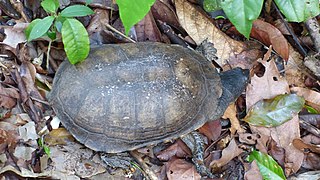
The cookiecutter shark, also called the cigar shark, is a species of small squaliform shark in the family Dalatiidae. This shark occurs in warm, oceanic waters worldwide, particularly near islands, and has been recorded as deep as 3.7 km (2.3 mi). It migrates vertically up to 3 km (1.9 mi) every day, approaching the surface at dusk and descending with the dawn. Reaching only 42–56 cm (16.5–22 in) in length, the cookiecutter shark has a long, cylindrical body with a short, blunt snout, large eyes, two tiny spineless dorsal fins, and a large caudal fin. It is dark brown, with light-emitting photophores covering its underside except for a dark "collar" around its throat and gill slits.

The Brazilian teal or Brazilian duck is the only duck in the genus Amazonetta. It is widely distributed in eastern South America.
The ballyhoo halfbeak or ballyhoo is a baitfish of the halfbeak family (Hemiramphidae). It is similar to the Balao halfbeak in most features. Ballyhoo are frequently used as cut bait and for trolling purposes by saltwater sportsmen. The fish is reported to have caused ciguatera poisoning in humans.

The giant otter or giant river otter is a South American carnivorous mammal. It is the longest member of the weasel family, Mustelidae, a globally successful group of predators, reaching up to 1.8 m. Atypical of mustelids, the giant otter is a social species, with family groups typically supporting three to eight members. The groups are centered on a dominant breeding pair and are extremely cohesive and cooperative. Although generally peaceful, the species is territorial, and aggression has been observed between groups. The giant otter is diurnal, being active exclusively during daylight hours. It is the noisiest otter species, and distinct vocalizations have been documented that indicate alarm, aggression, and reassurance.

Brasiliopuntia is a genus in the cactus family, Cactaceae. It contains only one species, Brasiliopuntia brasiliensis.

The commontapeti, also known as the Brazilian cottontail, forest cottontail, or (formerly) simply tapeti is a species of cottontail rabbit. It is small to medium-sized with a small, dark tail, short hind feet, and short ears. As traditionally defined, its range extends from southern Mexico to northern Argentina, but this includes several distinctive population that have since been split into separate species. Under this narrower definition, the true tapeti only occurs in the Atlantic Rainforest of coastal northeastern Brazil and it is classified as "Endangered" by the IUCN. The American Society of Mammalogists concurs, but also tentatively classifies several distinct populations that have not yet received proper species names into S. brasiliensis, and thus considers it to range from Venezuela south to Argentina.

The Brazilian tuco-tuco is a tuco-tuco species. It is found mainly in the state of Minas Gerais in southeastern Brazil, though Charles Darwin mentions it during his trip through present-day Uruguay.

The Brazilian brown bat is a bat species from South and Central America.
The orange-brown Atlantic tree-rat or red-nosed tree-rat, is a spiny rat species found in Brazil.

Holochilus brasiliensis, also known as the Brazilian marsh rat or web-footed marsh rat, is a species of semiaquatic rodent from South America. It is found in northeastern Argentina, southern and eastern Brazil and in eastern Uruguay.

The largetooth cookiecutter shark is a rare species of squaliform shark in the family Dalatiidae, reported from depths of 60–200 m (200–660 ft) at scattered locations in the Atlantic and Pacific Oceans. As its common name suggests, it is similar in appearance to the cookiecutter shark but has much larger lower teeth. This species reaches a maximum known length of 42 cm (17 in). The largetooth cookiecutter shark feeds by gouging out chunks of flesh from larger animals, including bony fishes, sharks, and marine mammals, and is able to take larger bites than I. brasiliensis. Little is known of its life history; it is thought to be a weaker swimmer than I. brasiliensis, and is presumably aplacental viviparous like the rest of its family. This shark is an infrequent bycatch of commercial trawl and longline fisheries, but is not thought to be much threatened by these activities.
Luetkenotyphlus brasiliensis, the São Paulo caecilian, is a species of caecilian in the family Siphonopidae. It is found in Misiones Province in northern Argentina and northwards to São Paulo state in Brazil; it likely occurs in adjacent Paraguay.

The Brazilian radiolated swamp turtle is a species of turtle in the Chelidae family endemic to Brazil.

The pocketed free-tailed bat is a species of bat in the family Molossidae found in Mexico and in Arizona, California, New Mexico, and Texas in the United States. They resemble the Brazilian free-tailed bat but differ morphologically. They are recognized as "least concern" by the IUCN and as "apparently secure" by Natureserve.

Dice's cottontail is a species of cottontail rabbit in the family Leporidae. It is found in Costa Rica and Panama, in páramo and cloud forest habitats.

Taddei's serotine is a species of medium-sized bat belonging to the family Vespertilionidae. It is restricted to the Atlantic Forest of southern Brazil.

The Serra Spanish mackerel is a species of fish in the family Scombridae. Specimens have been recorded at up to 125 cm in length, and weighing up to 6.71 kg. It is found in the western Atlantic, along the Caribbean and Atlantic coasts of Central and South America from Belize to Rio Grande do Sul, Brazil. Literature records for S. maculatus from the area apply to S. brasiliensis, which has erroneously been considered a synonym of S. maculatus by many authors. It feeds on small fish, squid/cuttlefish, shrimp/prawn, and isopods.
The coastal tapeti, also known as the Rio de Janeiro dwarf cottontail or dwarf tapeti, is a species of cottontail rabbit native to Brazil. Known from only three specimens, captured in the late nineteenth century in the Paraíba Valley, it was for a long time considered to be a subspecies of the common tapeti. Slightly smaller than its close relative, analysis in 2017 confirmed that it is sufficiently distinct in both appearance and genetics to be considered a species in its own right. Due to destruction of its putative habitat in the densely populated Paraíba Valley, it is unclear whether or not the species still survives in the present day.

The Andean tapeti or Andean cottontail is a species of cottontail rabbit native to Colombia, Venezuela, Peru and Ecuador. It was previously considered a subspecies of the common tapeti. Living at high elevations in the treeless Páramo of the Andes, analysis in 2017 confirmed that it is sufficiently distinct in both appearance and genetics to be considered a species in its own right. Although widespread, it remains poorly known, as few studies have been conducted on its biology and habits as distinct from those of the tapeti















